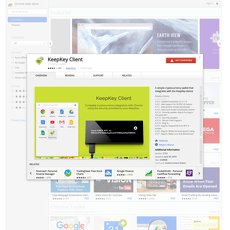DigiByte Go Wallet Review
DigiByte Go Wallet
chrome.google.com
DigiByte Go Wallet Review: Is Managing DGB in Your Browser Too Good to Be True?
Ever wondered why keeping tabs on your DigiByte has to feel like a chore? Or why swapping between apps just to manage your DGB is so frustrating, especially when you really just want to see your balance or send a quick payment? You’re definitely not alone, and trust me, there’s a reason more and more people are giving browser-based wallets like DigiByte Go Wallet a try.
There’s something magic about opening your browser tab and seeing your DigiByte right there—no separate app, no fuss, just simple crypto access exactly when and where you want it.
But let’s get real for a second. For every brilliant little browser extension that makes crypto easier, there’s a sketchy knockoff waiting to swipe your coins if you aren’t careful. If you’ve spent even ten minutes on Reddit or crypto Twitter, you’ve seen the horror stories: fake wallet apps, scammy Chrome extensions, and “DGB lost forever…” posts that make your stomach drop.
So why does it feel like picking the right DigiByte wallet is trickier than actually earning your DGB in the first place?
Why is picking the right DigiByte wallet so confusing?
Let’s face it, there are far too many wallet options, and every single one seems to shout:
- “We’re the most secure!”
- “We make sending crypto a breeze!”
- “We support everything you’ll ever need!”
But every crypto pro knows—it’s not all gold. Some wallets (especially browser extensions) cut corners on security, and some just straight out vanish, taking your DGB with them. If you’re googling ‘best DigiByte wallet’ and bouncing between comparison posts, you know exactly what I mean. What’s best for a total crypto beginner might be dangerous for a big holder, and vice versa. And Chrome extensions? They’re both super handy and scarily risky if you don’t pay attention to the details.
Here’s what you’ll get: Answers and solid advice
Lucky for you, you’re exactly where you need to be. I’ve hunted down the legit options, sniffed out the fakes, and I’ll give you honest, plain-English answers.
- Is DigiByte Go Wallet the real deal, or is it risky?
- What can you actually do with it—and what should you NOT use it for?
- How does it compare to hardware wallets or mobile apps?
And of course, you’ll get real-world, no-guesswork advice for staying safe no matter what wallet you’re using.
What are Chrome extension wallets anyway?
Alright, let’s clear some things up. Chrome extension wallets are crypto wallets you install straight into your Chrome (or Brave, Edge, etc.) browser. The convenience is unbeatable—no desktop programs, no phone needed, just open a tab and send your DGB while you’re checking your email. That’s the dream, right?
BUT, and it’s a huge but, browser extension wallets have a dark side. They’re the low-hanging fruit for scammers:
- Anyone can upload an extension to the Chrome Web Store (seriously, it takes like 10 minutes)
- Lookalike wallets, complete with stolen logos and names, flood the market
- One wrong click and bam—goodbye funds
Here’s a sobering stat: CipherTrace reports that in just one year, browser extension scams accounted for millions in lost crypto, with Chrome extensions being the #1 source of wallet theft for new users.
Just this year, one fake MetaMask extension swiped over $500,000 in user funds before getting delisted. And don’t think it can’t happen to DigiByte holders — all it takes is a slick phishing campaign and a few trusted influencers sharing the wrong link. Stay sharp!
So, the real question becomes: Is the DigiByte Go Wallet a shortcut to easy crypto, or a security headache waiting to happen?
Next up: What does DigiByte Go Wallet actually offer, and how do its features compare to the old-school approach? Hold tight—because this is where things get interesting.
What is DigiByte Go Wallet? Features, Pros, and Cons
Let’s cut through the noise—if you’ve ever tried using crypto browser wallets, you already know how hit-or-miss they are. DigiByte Go Wallet is a Chrome extension built for those who want managing DGB to be fast, simple, and always just a click away.
"Simplicity is the ultimate sophistication." — Leonardo da Vinci
But does DigiByte Go Wallet actually fit the way most of us use crypto? Maybe. Let me break down what you get and where things get a little tricky, so you can decide if this tool really deserves space on your browser toolbar.
Fast Overview: Who is DigiByte Go Wallet for?
Picture this: You’re tired of juggling logins, desktop apps, or clunky mobile wallets just to check your DGB stash or send a quick payment. DigiByte Go Wallet is designed for those everyday moves—paying a friend, moving coins off an exchange, or keeping an eye on live DGB balances, all from Chrome. If that’s you, this wallet was made for your workflow.
- Quick-checkers: If you like seeing your DGB at a glance without much fuss.
- Learners & testers: New to DigiByte and want a risk-light way to try things before committing big amounts.
- Active spenders: Fans of fast, low-fee sending and receiving DGB, like tipping on platforms or paying friends.
On the flip side, hardcore long-term holders or those with very large sums might want to think twice (I’ll get into why soon).
Main Features and User Experience
Let’s check out why people in the DigiByte community buzz about this wallet. DigiByte Go Wallet hooks right into Chrome, so your DGB account is as close as your bookmarks bar. Here’s what stands out:
- Instant access: Open a new tab, and your DigiByte wallet is right there. No more logging in, syncing apps, or switching devices.
- Send and receive DGB: Click, input an address, choose an amount, and hit send—it’s that simple. You can copy your address or scan a QR code for quick receiving.
- Seed phrase backup: You’re given a 12-word recovery phrase when you set it up. Keep that phrase safe—whoever has it, owns your crypto.
- Basic portfolio view: See your DGB balance and past transactions in a clean interface.
- Open-source (at the time of writing): The code is public, meaning the community can spot-check for sneaky backdoors (always double-check this before installing!).
The wallet feels stripped-back, on purpose; it’s all about DGB and nothing else. That makes things less cluttered and easier to learn, especially for first-timers. No over-the-top charts, risky DeFi integrations, or endless token lists to confuse you.
Pros & Cons List
All those great features sound nice, but here’s how it really shakes out when you’ve actually used DigiByte Go Wallet for a few weeks:
- Pros:
- Ultra-convenient for active users — Perfect if you’re making small, frequent transactions.
- Zero learning curve — Even total crypto newbies can figure it out in five minutes.
- Full control of your keys — You get your own seed phrase, so you’re the boss.
- Stays updated with DigiByte ecosystem — Usually among the first to support DGB updates.
- Free to use — No fees, just standard DigiByte transaction costs.
- Cons:
- Only DGB support — Forget about managing Bitcoin, Ethereum, or even DGB-based tokens here.
- Risk lives in your browser — If Chrome gets hacked or your computer is infected, your funds are at risk. (More on that in a moment...)
- No advanced features — Don’t expect staking, dApps, or custom token lists.
- Less ideal for large balances — Storing a huge bag of DGB? Think twice—browser extensions are always a bit riskier than hardware wallets.
This isn’t a “store your life savings” kind of wallet, and I wouldn’t use it for anything you can’t afford to lose. But for regular, small-to-medium DGB moves, it’s a solid everyday tool.
How This Compares with Other DGB Wallets
Maybe you’re weighing DigiByte Go against options like Trezor, Trust Wallet, or the official DigiByte Core client. Here’s a quick-hit comparison, so you don’t have to hunt down Reddit “pros and cons” threads:
- Trezor (hardware wallet): Absolute king for security—private keys never touch your PC. But it’s slower and much less convenient for daily DGB spending.
- Trust Wallet (mobile app): Multi-coin support, easy to use, some extra features. Still not as instant as a browser extension, but a nice in-between for security and convenience.
- DigiByte Core (desktop): Full node, max security, lets you help secure the DGB network. Heavy to run and definitely overkill for “I just want to tip my buddy $5 in DGB.”
- Exchange wallets: Fastest for trading, but zero control—if an exchange freezes, your coins are gone.
DigiByte Go Wallet slides right between “super easy” and “kinda secure,” carving out a niche for people who use DGB in everyday web life.
Let’s be honest: All this convenience makes you wonder—how safe is your DigiByte in a Chrome extension, really? I’ve seen too many headlines and horror stories about browser wallets gone wrong (including users who thought they were safe... until malware or a permissions pop-up said otherwise). Stay with me, because next I’m breaking down what security really looks like for DigiByte Go Wallet—including the ALL the risks nobody wants to admit. Did you ever wonder exactly what permissions these extensions ask for—or if they need them? That’s coming up next.
Is DigiByte Go Wallet Safe? Security Risks, Permissions, and Best Practices
Security isn’t just another box to tick—if you’ve spent even five minutes on any crypto forum, you know a simple wallet mistake can nuke everything. It’s not about being paranoid. It’s about staying one step ahead, especially when browser extensions have become a magnet for both convenience and chaos.
Real Risks of Chrome Extension Wallets
Let me get straight to it: Chrome extension wallets can be fantastic for quick access, but they’re also prime hunting ground for scammers. Remember the infamous fake MetaMask extensions that swept through the Chrome Web Store in 2022? Users woke up to empty wallets simply because they clicked the wrong “Add to Chrome” button without double-checking the source. Google does remove these, but usually only after people lose their funds.
Some of the most common attack methods I’ve seen:
- Phishing Extensions: Fake wallets that look and act exactly like the real thing, but send your details straight to thieves.
- Malicious Updates: Real extensions that get hijacked by attackers or sold and “updated” with malware baked in. Case in point: the recent 3CX supply chain hack (yes, even reputable-looking software can turn rogue overnight).
- Permission Hijacks: Extensions asking for permissions they don’t really need, granting access to browsing activity, clipboard, or even managing tabs—all prime ways to scoop up sensitive info.
A 2023 study by Palo Alto Networks found that more than 500,000 users were affected by malicious Chrome extensions in one year. It's not a small risk—but it's one you can sidestep with smart habits.
“The best armor is to keep out of range.” — Italian proverb. And in the world of browser extensions, that range is closer than you think.
What Permissions Does DigiByte Go Wallet Ask For?
Every wallet extension has to ask for some access just to do its job. But what you’re looking for are red flags—permissions that don’t make sense for a crypto wallet.
When I checked DigiByte Go Wallet, here’s what the real thing typically asks for:
- Read and change your data on sites you visit: Needed for integrating with web apps or pulling blockchain info.
- Display notifications: Standard if you want alerts about transactions.
- Access clipboard (sometimes): Handy if you’re copy-pasting addresses—but treat this with caution (more permissions = more ways things can go wrong).
What it should NOT ask for:
- Managing all your downloads
- Tracking your entire browsing history
- Modifying your settings, bookmarks, or passwords
If you see anything on that second list, back off immediately. Never shrug off a long permission list—there’s always a reason for it, and sometimes it’s not in your favor.
Staying Safe: My Checklist Before You Click “Add to Chrome”
Here’s my personal security playbook whenever I look at a new wallet extension (and especially before I trust it with DigiByte):
- Only download from official sources: If the Chrome Web Store page isn’t linked from the official DigiByte site, stay away. Scammers love buying ads or copying legit logos to trick you.
- Check the developer and publisher: Is it the official DigiByte Foundation or someone random with no public track record? Don’t be afraid to dig for info—search the publisher’s name, look for their site, and check their presence in real DigiByte communities.
- Read reviews—but with a critical eye: Fresh extensions with hundreds of five-star ratings overnight? Red flag. Go through recent reviews, and pay attention to genuine complaints (or users mentioning scams).
- Research updates: When was the last update? If it hasn’t been updated in ages, or it was just “relaunched” after years of silence, be suspicious.
- Verify permissions on install: Chrome tells you exactly what access the extension wants. If it’s asking for stuff no wallet should need, stop right there.
- Keep seed phrases & private keys OFF the web: Never, ever paste your seed phrase into suspicious sites or forms. If an extension guides you outside Chrome or asks for unusual backup methods, that’s your cue to exit.
Feeling overwhelmed? You’re not alone. These steps take two minutes, and they save you from headaches that can ruin your year. Remember, once a scammer gets hold of your DGB, there’s no “undo” button.
So, you’re probably thinking: “Alright, if I’m careful, how do I actually set this up the right way without making a rookie mistake?” Perfect—because that’s exactly what’s coming up next. Want to install DigiByte Go Wallet the safe way, and see every step (with zero guesswork)? Let’s get your first transaction ready without risking your coins—keep reading for the step-by-step breakdown!
How to Set Up and Use DigiByte Go Wallet (Step-by-Step)
Ready to start using DigiByte straight from your browser but not sure where those first clicks should go? You’re in the right spot. Grabbing the DigiByte Go Wallet Chrome extension is just the beginning—the rest is about avoiding mistakes and making your life simple (and safe). I’m here to show how to get running with it… minus the stress and confusion that trips up most people.
First Install: Step-by-Step Process
Let’s get the basics right—because all it takes is clicking the wrong download link and, bam, you’re in scam territory. Always use the official source. Here’s exactly how to keep yourself in the clear:
- 1. Find the official chrome extension: Go straight to the Chrome Web Store and search for “DigiByte Go Wallet”—don’t rely on Google ads, sponsored links, or Telegram groups.
- 2. Check the publisher: Make sure you’re seeing “DigiByte Foundation” or the exact dev team behind the project. Look at download numbers, read some reviews, and glance at the version update date. If it looks outdated or there are tons of complaints about missing coins, stop right there.
- 3. Install from Chrome Web Store: Click “Add to Chrome.” Chrome will list the permissions the extension wants—if you see anything weird or suspicious (like “communicate with other apps” without reason), trust your gut and step back.
“The single biggest threat to your crypto isn’t technology or hackers. It’s impatience—rushing through setup and ignoring warning signs. Slow down, double check, and trust your gut.”
Initial Setup: Creating/Restoring Your Wallet
First time setting up? DigiByte Go Wallet makes it simple, but this is the step where people lose keys (and sleep). Here’s what you’ve got to do:
- Choose: New Wallet or Restore?
- Create new wallet: The extension will show you a seed phrase—that’s your lifeline. Write it down on paper, never in an email or screenshot. Store it somewhere only you can get to—studies have shown most lost coins come from lost seeds, not hacks.
- Restore wallet: Already have a seed? Select restore, carefully type out the phrase. If even one word is wrong, it won’t work. (Hint: triple check for typos.)
- Set a strong password: Don’t repeat old passwords, and avoid obvious stuff (no “DigiByte123” please!). Use a password manager if you have to.
- Backup reminder: Copy those backup instructions. Some folks go the extra step and split the seed across two places—just don’t leave it sitting in your downloads folder.
I’ve heard from dozens of readers who skipped this and, weeks later, couldn’t get back in after reinstalling Chrome or switching PCs. Save yourself the heartache and just do it right the first time!
Sending, Receiving, and Managing DigiByte (DGB)
Alright, now you’re in. Here’s what actually using DigiByte Go Wallet looks like—and let me tell you, you don’t need to be a blockchain wizard:
- Receive DGB: Click “Receive” to get your address (looks like long string of letters/numbers). Share that with whoever’s sending you DGB—whether it’s a friend, a payout site, or you moving funds from another wallet. The QR code option makes things fast if you’re doing this from your phone.
- Send DGB: Hit “Send,” enter the target wallet address and amount. Double-check addresses—one wrong character and those coins are gone forever. Pro tip: paste and compare the first and last 4 characters for safety.
- Check your balance and history: The extension dashboard shows your total, recent transactions, and confirmations. If you want more details, you can usually click through to a DigiByte block explorer.
- Limits and quirks: You’re managing mainnet DigiByte—not tokens or staking. For more advanced features, you’ll need to look at full desktop/mobile wallets.
It’s honestly that straightforward—but only if you slow down and pay attention at the right moments.
Still unclear on how this browser wallet stacks up against other ways to hold DigiByte, or wondering if it plays nice with Trust Wallet or hardware wallets? Hold on—the next section’s going to answer the questions you’ve likely searched for (and the ones most people miss).
Top FAQs: DigiByte Go Wallet and DigiByte in Your Browser
Let's get straight to the good stuff—those real-life questions that everyone Googles when exploring DigiByte Go Wallet, browser wallets, and the DigiByte ecosystem. I see these pop up in Reddit threads and Telegram chats all the time, and believe me, having clear answers makes a massive difference. Let’s clear up the confusion right now.
Which wallet supports DigiByte?
DigiByte isn't short on wallet options, but the landscape does change depending on your priorities—speed, security, or flexibility.
- DigiByte Go Wallet: Super convenient as a Chrome browser extension. Perfect for quick access, daily transactions, and keeping things lightweight. If you’re hopping between browser tabs and don’t want to juggle another desktop app, this one’s a solid pick.
- Hardware wallets (like Trezor): If cold storage is your top concern, hardware wallets are king. You get the best security for long-term holdings, but convenience takes a back seat since you have to physically connect your device for transactions.
- Trust Wallet: A mobile-first wallet that covers DigiByte, plus a ton of altcoins. Handy if you like to check your balance or transact while on the move.
- DigiByte Core/DigiByte Mobile: The official desktop and smartphone wallets with full support and development from the DigiByte team. You get the confidence of using what the devs themselves trust.
I always say: match the wallet to your lifestyle. Going for maximum convenience? Browser wallets like DigiByte Go are speedy and simple. Holding a life-changing amount of DGB? Go hardware or official desktop.
Can I use DigiByte Go Wallet with Trust Wallet or hardware wallets?
Here’s where a lot of folks get tripped up: can you use DigiByte Go Wallet alongside Trust Wallet or a hardware wallet? The short answer is—they’re not plug-and-play compatible, but you’re not stuck with just one tool.
- Restoring wallets: If your wallets use the same backup phrase standard (like BIP39), it’s possible to import/export between some wallets. But always double-check the compatibility on each wallet’s documentation. Don't just assume—seriously, go read the FAQs.
- Hardware support: DigiByte Go Wallet doesn’t natively support hardware wallets at the extension level. If you want cold storage, your best bet is Trezor or Ledger, using their own official interfaces.
- Multi-wallet strategy: You can absolutely use DigiByte Go for daily spending and Trust Wallet or Trezor for savings. Just don’t copy-paste sensitive seed phrases between browser-based extensions and cold storage unless you’re 100% sure you’re in a secure environment.
Want a pro tip? Treat DigiByte Go as your “checking account” wallet—quick, handy, but for modest amounts. Keep your “vault” (aka savings) on your hardware wallet or a mobile wallet that never touches unknown Wi-Fi. That’s the setup most experienced users swear by.
What network does DigiByte Go Wallet use?
This one’s clear-cut: DigiByte Go Wallet communicates directly with the DigiByte blockchain. You’re not dealing with wrapped tokens, network bridges, or chains of trust you can’t verify.
DigiByte isn’t just another BTC clone, either. Its MultiAlgo mining means five algorithms run in parallel, spreading hash power and making it super resistant to a single-point attack (hello, 51% defense!). To put it bluntly: you’re always transacting natively on the DigiByte mainnet, so every send, receive, or balance you see in DigiByte Go is real DGB secured by DigiByte’s full decentralized network.
What are DigiByte’s real-world use cases?
DigiByte is more than just quick transactions—it’s grown into a multi-purpose blockchain with some underrated use cases (that browser wallets make even more accessible):
- Payments: With ultra-low fees and assets moving in seconds, DigiByte’s ideal for remittances and daily purchases (especially where speed is king).
- NFTs: Yep, DigiByte’s blockchain supports digital collectibles. Mint, transfer, sell—no gas wars like Ethereum, so it’s great for smaller creators and indie projects.
- DigiAssets: Custom tokens (like loyalty points or digital tickets) are a thing, and browser wallets can make sending and receiving a breeze.
- Secure Messaging and Document Verification: DigiByte has been used for anchoring data, offering timestamped document proof, and anti-tampering—isn’t just about cash.
Having a browser wallet like DigiByte Go means these features are just a click away, no more jumping through technical hoops. Picture buying NFT art, sending a tip, or verifying a digital certificate—all straight from your browser tab. That’s what mainstream adoption looks like.
Still wondering how safe browser wallets really are for your crypto or what setup will help you actually sleep better at night? You’re about to get a straight-shooting answer—and a few tricks I wish someone told me years ago—in the next section. Ready to see if you should trust DigiByte Go Wallet (and browser extensions in general) with your hard-earned DGB? Stick with me, because you’ll want what’s coming next.
Final Thoughts: Should You Trust DigiByte Go Wallet & Browser Extensions for Crypto?
Here’s the straight-up answer: DigiByte Go Wallet is one of those tools that can make managing DGB incredibly easy and fast—just a click away, and you’re in. But is it perfect for everyone? Not quite. You always want to treat browser extension wallets a bit like public WiFi: super useful when you need them, but you’d never send your life savings over them.
Is DigiByte Go Wallet the right choice for you?
Let’s get brutally honest. DigiByte Go Wallet fits best if you:
- Need quick, on-the-fly DGB access (maybe you’re active with tipping, micro-payments, or just check balances a lot).
- Understand basic crypto security, like never posting your seed phrase anywhere, and you’re comfortable using browser extensions safely.
- Don’t plan to hold huge amounts of DigiByte—it’s decent for coffee money, not your retirement stash.
If you’re looking for something to hold a substantial stack or want multi-layer security, a hardware wallet (like Trezor, Ledger) or a solid mobile wallet is still the best move. There have been too many extension-based wallet mishaps to recommend otherwise—think of the rogue extensions that managed to steal funds from thousands in 2022 alone. Chrome even published a security blog post on the metastasizing extension scam problem. The bottom line: with browser wallets, the risk is higher. Not sky-high, but always present.
Extra Resources & Smart Next Steps
You don’t have to wander around crypto Reddit or Discord trying to figure out up-to-date security. I built a resource just for that: check my Ultimate Guide to Cryptocurrency Chrome Extensions—all the ways you can spot a fake or insecure extension before your DGB ever touches it.
If you want wallet reviews that don’t pull punches, or want to compare DigiByte Go to every legit option (web, mobile, hardware), use the huge reviews section on Cryptolinks.com. And if you want to keep tabs on what DigiByte devs are up to, or ask questions straight to other users, the DigiByte Telegram and Twitter/X communities are active, responsive, and not filled with scammers—an exception in crypto.
Takeaways and What I’d Do If I Were You
- Never rush to install any crypto wallet from a random link or ad. Wrong moves here can cost you everything. Always double-check the developer and the official website. There are Chrome clones that look perfect until your coins vanish.
- Think about risk like this: browser extension wallets are perfect for handling “spending cash,” not your full stack. If your DGB balance would give you a panic attack if stolen, put it in a hardware wallet or a battle-tested mobile wallet instead.
- Set up healthy browser habits: keep a separate Chrome profile just for crypto, delete extensions you don’t use, and review permissions regularly. There’s a reason why most Chrome wallet attacks rely on compromised browser settings, not wallet bugs.
- Back up your recovery phrase—but never on your computer or phone. Physical paper, encrypted USB, whatever works. Just don’t leave it anywhere a virus (or a nosy roommate) can get at it.
If I had to sum it up? Browser wallets like DigiByte Go are clutch for speed, daily bits-and-bobs, and micro-payments. But treat them with a little paranoia, and always keep your main stash in something more secure. That’s how you keep ahead of the scams while still enjoying the freedom that DigiByte (and crypto) is meant to deliver.
Managing DigiByte can be just a click away—but only if you do it smart. Stay safe, stay sharp, and enjoy the ride.










